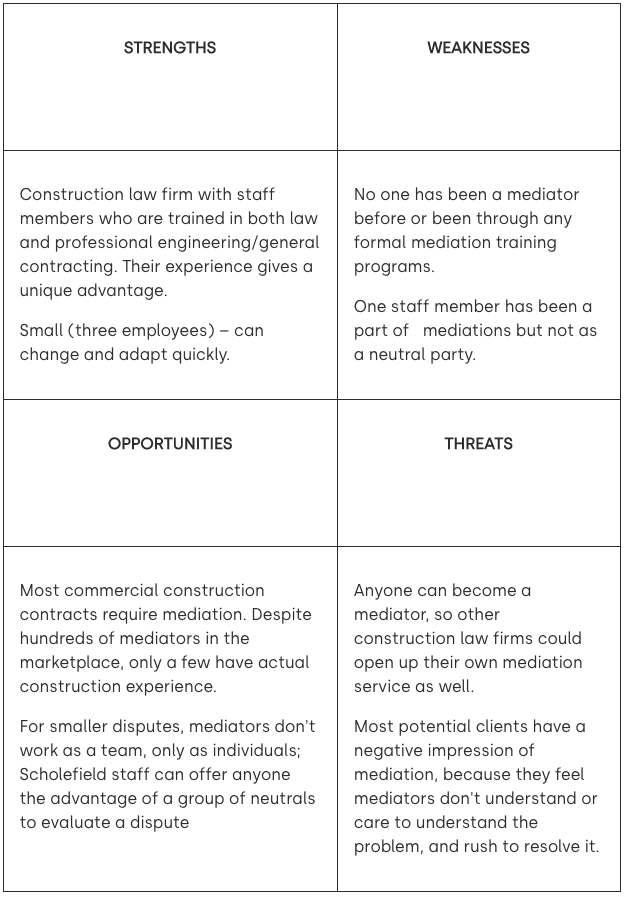
SWOT Analysis Explained & When Your Business Should Use It
- A SWOT analysis is a detailed list of strengths, weaknesses, opportunities and threats facing your business.
- The main goal in conducting a SWOT analysis is to highlight all of the factors that should impact your business strategy.
- Perform a SWOT analysis prior to committing to a particular company action, whether its altering company policy, embarking on new opportunities or changing course for a project midway through execution.
- Discover strategies and recommendations with SWOT analysis to leverage your opportunities and strengths to overcome threats and weaknesses.
If you want to run a successful business, regularly analyze your procedures to ensure maximum efficiency. Although there are a variety of ways you can assess company performance, SWOT (strengths, weaknesses, opportunities and threats) analyses remain one of the most effective methods.
A SWOT analysis is a proven planning process that will help your business overcome difficulties and identify new leads that are worth pursuing.
The main purpose of a SWOT analysis is to inform a company about all of the internal and external factors surrounding a particular business decision. The method was first created by Albert Humphrey of the Stanford Research Institute during the 1960’s in order to understand why corporate planning commonly failed.
“It is impossible to accurately map out a small business’s future without first evaluating it from all angles, which includes an exhaustive look at all internal and external resources and threats,” says Bonnie Taylor, chief marketing strategist at CCS Innovations. “A SWOT accomplishes this in four straightforward steps that even rookie business owners can understand and embrace.”
When Should You Conduct a SWOT Analysis?

Perform a SWOT analysis prior to committing to a particular company action, whether its altering company policy, embarking on new opportunities or changing course for a project midway through execution. Periodically perform general SWOT analyses to keep an eye on your current business landscape so you can make adjustments as needed. This will highlight what areas in your organization are doing well and what areas need to be improved.
You shouldn’t be informal when analyzing your business operations, hoping everything will come together in a cohesive way. If you take the time to conduct a formal SWOT analysis, you’ll be able to see the entire picture of your business’s current state. Once completed, use strategic planning to improve on internal weaknesses in your company while taking advantage of its strengths.
It’s helpful for a business owner to include other team members when creating a SWOT analysis so that a variety of perspectives can contribute to a fuller understanding of the company’s current state.
SWOT Analysis Characteristics

SWOT stands for Strengths, Weaknesses, Opportunities and Threats. Analyzing these 4 elements allow a company to identify the factors influencing an initiative, strategy or action. Highlighting these negative and positive elements allows a company to communicate effectively about what parts of a plan need to be recognized and altered.
When creating a SWOT analysis, people generally create a table that is split into 4 columns with each column devoted to one of the specific elements. Weaknesses and strengths usually will not match the listed threats and opportunities you have listed, but they will correlate with one another since they ultimately linked together.
Managing director of Royce Leather, Bill Bauer, noted that linking internal weaknesses with external threats is a good way to put a spotlight on the most serious issues facing a company.
“Once you’ve identified your risks, you can then decide whether it is most appropriate to eliminate the internal weakness by assigning company resources to fix the problems, or to reduce the external threat by abandoning the threatened area of business and meeting it after strengthening your business,” said Bauer.
Internal factors
Strengths and weaknesses are internal factors, namely resources and experience.
Examples of internal factors include
- Financial resources – sources of income, investment opportunities and funding
- Physical assets – equipment, location and facilities
- Human resources – target audience, volunteers and employees
- Availability of natural resources, copyrights, patents and trademarks
- Current company processes – programs for employees, structural hierarchies and software systems like accounting and CRM software
External factors
External factors affect every individual, company and organization. These forces can be directly or indirectly related to opportunities and threats.
External factors include
- Market trends (new technology and products and shifts in the needs of your audience)
- economic trends (financial trends on a local, national or international level)
- Funding (through the government, donors or other sources)
- Demographics
- Relationships with partners and suppliers
- Regulations (environmental, economic and political)
After you complete your SWOT analysis, it’s time to use the results to come up with strategies and recommendations. These strategies should aim to leverage opportunities and strengths to overcome threats and weaknesses.
This is the area in your strategy development that will give you the most most freedom for creativity and the birth of new innovative ideas, but the first step is conducting a thorough and complete analysis
SWOT Analysis Example
The SWOT analysis below was used by Bryan Weaver, a partner at Scholefield Construction Law, when the firm was trying to decide wether to expand its area of practice into dispute mediation services. That particular SWOT framework is shown below:

Resulting strategy: Eliminate weaknesses by taking mediation courses and launching Scholefield Mediation.
Weaver stated that “our SWOT analysis forced us to methodically and objectively look at what we had to work with and what the marketplace was offering. We then crafted our business plan to emphasize the advantages of our strongest features while exploiting opportunities based on marketplace weaknesses.”
Bonus Strategies for Analyzing Your Business
The SWOT analysis is a straightforward, comprehensive strategy that helps identify not only the threats and weaknesses of a plan of action but also the opportunities and strengths that plan of action makes possible.
A SWOT analysis, however, is only one of the many tools in your business strategy. Additional tools worth looking into are the SCRS analysis (strategy, current state, requirements and solution), MOST analysis (mission, objective, strategies and tactics), and PEST analysis (political, economic, social and technological).
If you want to keep track of your strengths, weaknesses and company growth, strategic planning and regular analysis of your business is your best path forward. Use a variety of business analysis strategies in your decision making process if you want to evaluate and execute your tactics in a more in-depth, balanced way.



















